Historic Surge Of Yamuna River In Agra Reaches Taj Mahal's Boundaries

Taj Mahal
- The Yamuna River in Agra has surged to a height of 495.8 feet, surpassing the 'low flood level' and encroaching upon the iconic Taj Mahal.
- Precautionary measures have been implemented along the river ghats, while officials intensify relief efforts amidst the flood-like conditions.
Prince Vajpayee, a conservation assistant at the Archaeological Survey of India (ASI), highlighted the remarkable design of the Taj Mahal, attributing its resilience to floods. He emphasized that the main mausoleum was meticulously planned to prevent water from entering its structure, even during severe flooding. In an interview with the Economic Times, Vajpayee stated, "The monument was ingeniously crafted to ensure the main structure remains protected from water ingress, even during periods of high floods," reported Hindustan News.
In order to prevent floods, authorities have taken precautionary measures by installing barricades along the river ghats, stretching from Kailash Temple in Sikandra to the Dusshera Ghat near the Taj Mahal.
In response to the flood-like conditions in Agra, officials have intensified their relief preparedness. As the Yamuna River continued to rise, it resulted in the flooding of nearby roads and a crematorium in Tajganj. Additionally, the water level reached the wall of the Itmad-ud-daulah monument. The Yamuna Kinara Road, which leads to the Taj Mahal, also experienced waterlogging due to the overflowing drains that discharged into the flooded river.
As of 4 pm on Sunday, the water level in the Yamuna River had reached 495.8 feet. In Agra, the low-flood level for this river is set at 495 feet, with the medium flood level at 499 feet and the high flood level at 508 feet, according to Yashvardhan Srivastav, ADM (Finance and Revenue).
In anticipation of a flood-like situation, necessary measures have been taken to address the potential challenges. Posts have been established, and boatmen and divers are on high alert. Local residents in low-lying areas have been advised to remain vigilant, added Srivastav.
The increase in the Yamuna's water level is attributed to the discharge of water from two barrages in the past 24 hours. The Okhla Barrage released 1,06,473 cusec of water, while the Gokul Barrage in Mathura, with all seven gates open, released 1,24,302 cusec of water. Nevertheless, the escalating water levels have once again drawn attention to the persistent problem of pollution in the Yamuna River. The contaminated waters have been identified as a substantial menace to the Taj Mahal, playing a role in its discoloration and deterioration.
Meanwhile, following a consistent decline in the water level of the Yamuna River over the course of three days, a minor rise was observed on Monday, with the level increasing from 205.45m at 6 am to 206.01m at 11 pm. However, both the Delhi government and the irrigation and flood control (I&FC) department reassured the public that there was no cause for alarm. Officials attributed the change to local contributions from drains and regional rainfall.

















